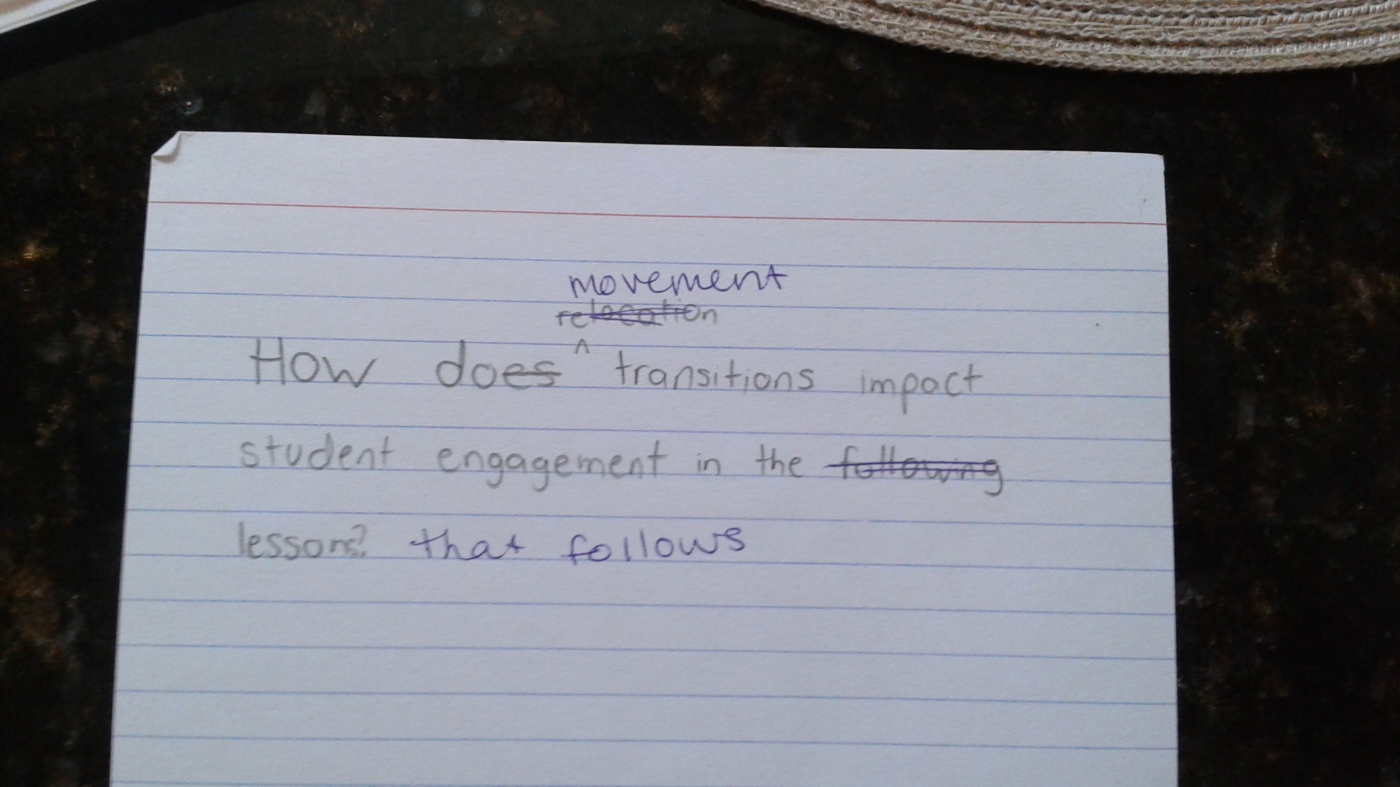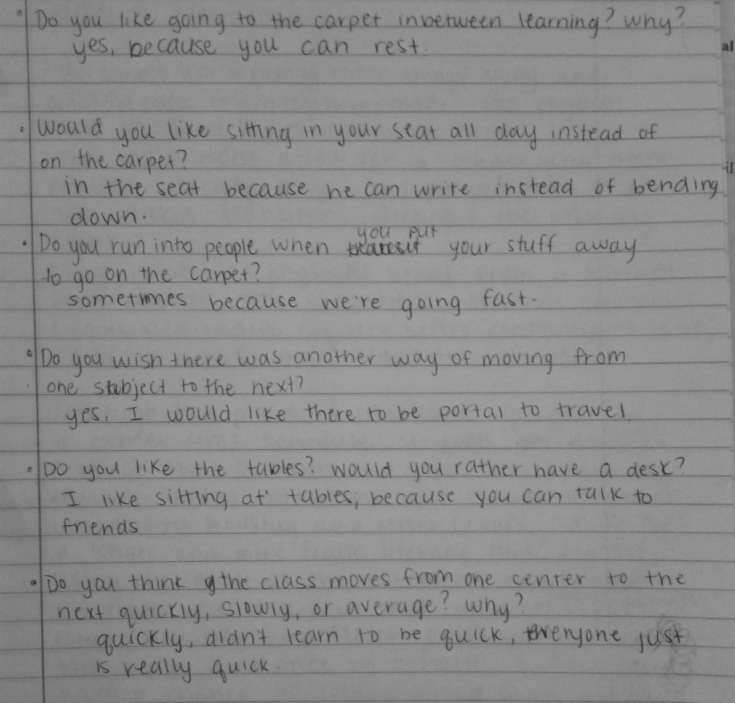This week of inquiry, provided me with a chance to revisit my wondering and really establish what I wanted to study. After rewording and reworking my inquiry, I had a new focus for my inquiry. I had always known I wanted to focus on transitions within my class, but my wondering was a little spread out and unrefined leaving me faced with a large study that I didn’t know how to undertake. My new inquiry wondering focuses solely on how the movement of the transition impacts the engagement and time usage in the lesson that follows. I decided to eliminate the table arrangement and classroom setup portion of my inquiry. I came to this decision to rework my inquiry after a collaboration activity with my critical friends group (CFG). Through this we wrote down our wondering and switched them around the group to answer questions. This was in an effort to refine the wonderings within our group Having this opportunity gave me the ability to bring in explanations for any unanswered questions or possible confusions. Even though this wasn’t an action that I implemented in the class, this piece of data collection could potentially be more influential. This data gives me guidance on what data to collect to really view what I’m interested in and is the most influential factor or engagement and time usage. I think that although the tables may be a factor in the transitions, I think that the effect of it is so minute that focusing on just the movement would be much more interesting and show more information to make claims. The students didn’t really have any part in this piece of data collection, but they are the ones that this data will affect because I’ll be studying their reactions of this new wondering. With this new inquiry wondering, one of the actions I researched talked about independent versus group contingencies. I wanted to view how using group versus independent contingencies influence the transition. This would give me the knowledge on which reward system to use consistently use when collection my data, so that I wouldn’t have to many factors that come into play. The best way to show my data for this action, I thought, was through a journal reflection that compared to my two experiences.
The past week I’ve been observing how the students engagement changed between using independent and group contingencies (rewards). The types of rewards that I used were the rewards already established within my classrooms management system. For the independent rewards, I used the clip system. This clip system consists of seven colors. All the students come to everyday on the neutral middle color (green). If they do something notable, such as follow transition routines quickly and quietly. For the group contingencies, we have the table points in which the students only get points if everyone in their group are on task and following directions. From my trial this week, I rewarded individual students (to clip up) if they were on the carpet quickly and they were sitting in their spot with their hands in their lap and sitting quietly, ready to move on. When I did this the students seemed to follow suit more quickly and came to await the next thing (or to see if they would clip up too). The group contingency of table points seemed to have a different outcome. Although the students wanted the points, there wasn’t any difference in the whole class engagement level. The students’ self-motivation seemed to over ride the motivation that derives from a group to be engaged. After moving to the carpet after completing math, I would explain the next subjects information and directions. Then I would tell students to tip-toe to their tables. I would have informed students prior to their release to give me a thumbs up when they were ready (my engagement sign). The time-engagement ratio of the students were higher on the days when I used the individual clip system. Thus, more students were engaged in less amount of time. This relates to my inquiry because this independent variables could have impacted my inquiry of understanding how the movement alone influenced and impacts the lesson. Now understanding that the individual contingencies reap a better time-engagement ratio, I will keep that aspect fixed so that I am able to get a true study on the movement rather than the reward. My next steps will involve making a lot of observations and adding to my time/engagement chart when implementing the action of having movement to the carpet verses not moving to the carpet for transitions. I want to view if that time/engagement ratio will differ and in what ways they will differ. Additionally within this I’m curious to see if there are certain students who might respond better to no movement verses movement.
The most powerful form of formative data I collected this week was the journal reflection. I think this is because as I continue on my inquiry, I am able to get a true reading of how movement only impacts the students’ engagement and time usage. This week I learned that wonderings can change through inquiry and that’s perfectly okay. This shows that your learning and being a reflective educator. Additionally in relation to my students, I learned that they respond better to independent rewards when transitioning. I know now to reward independently when I plan on collecting data. I believe that my Critical Friends Group was important to my inquiry because I have a new founded guidance that will keep me more focused as I collect data. My data won’t seem as scattered so as I go to analyze and present my inquiry I will have viable clams that support what I have been doing. This data supports my inquiry because it shows I am flexible and reflective as a researcher. It shows that I’m open-minded and able to take other people’s perspectives into account. This is important when researching because you don’t want your data, claims, or actions to be biased. The data I collected for the independent verses group contingencies support my learning because “the students self-motivation seemed to override the motivation that derives from a group to be engaged” (journal reflection). This data allows me to keep things consistent and fixed so that I can limit the factors that could focus on the outcome and limit the remaining questions related to the factors. the actions that I think I will take next week include looking at if the engagement changes based on the activity that follows. I will use the same transitions during the same time of day, but I will just use different activities. This will show me if the movement of the transition is the true factor of engagement or if it was the activity. Another thing I’d like to look at is using different movements during transitions to see the effect and impact of the engagement and time usage. This data I will probably study into the next week as well because this is a main data point of my inquiry. Based on the data I have collected, I still wonder if thee are any other factor that influence my results. Although I can’t five everything in a study, I’d like to get the truest reading as possible. Engagement is a tricky thing to study because of all the possible influential factors that could come into play.






Recent Comments